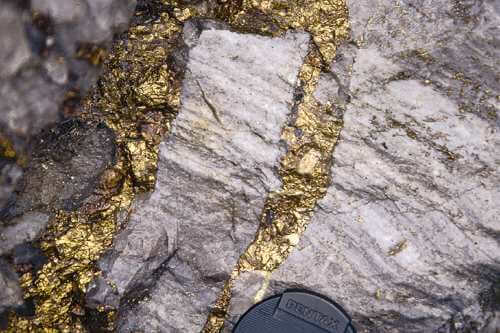Dissemination of Gold.—The wide distribution of gold in minute quantities throughout the world was pointed out by W. E. Dubois, an Assayer in the United States Mint, in 1861, and is further attested by a large number of specimens now in the Percy collection. These consist of small specks of gold of different sizes which have been obtained from the most varied sources. Thus, samples of Pattinson’s crystallised and uncrystallised lead, pig lead from all countries, lead fume, red lead litharge, white lead, precipitated carbonate of lead and acetate of lead were all found to contain gold, which seems to be invariably present in galena. Moreover, it appears to be impossible to procure samples of copper in which gold cannot be detected, although the Lake Superior copper contains less than one part in 1,000,000; the bronze and copper coins of all nations are usually found to contain much greater quantities of gold than this. Similar evidence has been adduced which tends to show that all ores of silver, antimony and bismuth contain gold.
L. Wagoner found minute quantities of gold and silver in a number of rocks taken from localities remote from veins or regions known to contain valuable minerals. Granites were found to contain an average of 0.37 part of gold per million (equivalent to over 5 grains of gold per ton), and 3.85 parts of silver per million. Sandstones contained an average of 0.03 part of gold per million, and marble 0.007 part, with larger amounts of silver. J. E. Spurr drew the deduction that igneous rocks contain more gold than sedimentary rocks, and that the order of richness of the sedimentary rocks in gold and silver may, on further investigation, prove to be (1) clays and shales, (2) sandstones, (3) limestones. The gold is no doubt derived in these cases from the sea, and is concentrated where much organic matter is present. It was found many years ago at the Royal Mint that coal from the North of England contained gold.
The occurrence of gold in solution in seawater has been proved by Sonstadt, who states that it is far less than 1 grain per ton. Liversedge subsequently showed that the amount of gold in sea water off the coast of New South Wales is from 0’5 to 1 grain per ton, or in round numbers from 130 to 260 tons of gold per cubic mile. Dr. Don could not precipitate the gold from seawater either by charcoal, by insoluble sulphides, by metals or by a current of electricity. Wagoner § found 0-17 grain of gold per ton of water off San Francisco; and a statement has been made that about 1/30 grain of gold per ton occurs in the water round the English coasts.
THE NATURAL DISSEMINATION OF GOLD
It is now nearly a quarter of a century since the people of Philadelphia were startled by the report that the bricks of their houses, as well as the clay beneath their streets, contained an appreciable proportion of gold. The revelation emanated from the Assay Office of the Mint; and the same authority that announced to every landowner his proprietorship in the treasure-trove, denied to him the means of extracting the wealth which Nature, with such even-handed justice, had distributed through her wide domain.
In June, 1861, the then Assistant Assayer, Mr. William E. DuBois, read before the American Philosophical Society a paper “ On the Natural Dissemination of Gold,” briefly setting forth the results of a series of investigations conducted by Mr. Jacob R. Eckfeldt, the Assayer of the Mint. These formed the basis of some curious propositions and calculations which the author so interestingly presented, as to lead to the republication of the pamphlet in England, as well as to countless abstracts by the daily press of our own country. Since then, there have been tidal waves of inquiry, and piecemeal expositions of the subject, the newspapers far and wide catching it up, copying and recopying from one another, diminishing truth and multiplying error, until it would seem that the time has now arrived for a fresh start in an authorized republication. While not strictly apropos of numismatics, there are reasons why this account of a treasure-trove may not be altogether out of place and certainly not void of interest to the readers of -the Journal. I therefore reprint the main portion of the original report, as follows:
“To assert that Gold is at once a very rare and a very abundant metal, would seem to be an abuse of language; and yet, in a certain sense, it would be true in both branches of the proposition. Iron, in its many mineralized forms, has been profusely scattered by the Creative Hand all over the world ; and gold is found in so many natural situations and alliances where it would not be looked for, as to hold out the expectation that a diligent search would find it almost as widely, though by no means so plentifully, diffused. Such is not the fact in regard to many other metals, but it is remarkably true of the two which stand in the market at the head and foot of the list.
“These remarks are preliminary to the detail of several interesting examinations lately made by Mr. Eckfeldt, the principal Assayer of the Mint, from time to time, as opportunities of leisure would allow.
“The first experiments were made upon galena, or native sulphide of lead. It was well known that this was occasionally found to contain gold in
